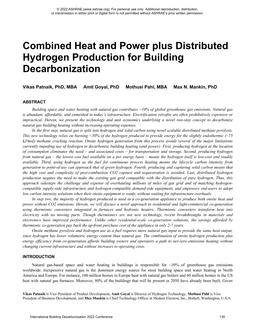
C17 — Combined Heat and Power plus Distributed Hydrogen Production for Building Decarbonization
- Comments Off on C17 — Combined Heat and Power plus Distributed Hydrogen Production for Building Decarbonization
- ASHRAE
Click here to purchase
Building space and water heating with natural gas contributes ~10% of global greenhouse gas emissions. Natural gas is abundant, affordable, and enmeshed in today’s infrastructure. Electrification retrofits are often prohibitively expensive or impractical. Herein, we present the technology and unit economics underlying a novel two-step concept to decarbonize natural gas building heating without increasing operating expenses. In the first step, natural gas is split into hydrogen and solid carbon using novel scalable distributed methane pyrolysis. This new technology relies on burning <50% of the hydrogen produced to provide energy for the slightly endothermic (~75 kJ/mol) methane cracking reaction. Onsite hydrogen generation from this process avoids several of the major limitations currently impeding use of hydrogen to decarbonize building heating (and power): First, producing hydrogen at the location of consumption eliminates the need – and associated costs – for transportation and storage. Second, producing hydrogen from natural gas – the lowest cost fuel available on a per energy basis – means the hydrogen itself is low-cost and readily available. Third, using hydrogen as the fuel for continuous process heating means the lifecycle carbon intensity from generation to point-of-use can approach that of green hydrogen. Fourth, producing and capturing solid carbon means that the high cost and complexity of post-combustion CO2 capture and sequestration is avoided. Last, distributed hydrogen production negates the need to make the existing gas grid compatible with the distribution of pure hydrogen. Thus, this approach sidesteps the challenge and expense of overhauling millions of miles of gas grid and of matching hydrogencompatible supply-side infrastructure and hydrogen-compatible demand-side equipment, and empowers end-users to adopt low carbon intensity solutions when their onsite equipment is ready, without waiting for infrastructure overhauls. In step two, the majority of hydrogen produced is used in a co-generation appliance to produce both onsite heat and power without CO2 emissions. Herein, we will discuss a novel approach to residential and light-commercial co-generation using thermionic converters integrated in furnaces and hydronic heaters. Thermionic converters transform heat into electricity with no moving parts. Though thermionics are not new technology, recent breakthroughs in materials and electronics have improved performance. Unlike other residential-scale co-generation solutions, the savings afforded by thermionic co-generation pay back the up-front purchase cost of the appliance in only 2-7 years. Onsite methane pyrolysis and hydrogen use as a fuel requires more natural gas input to provide the same heat output, since hydrogen has lower volumetric energy content than natural gas. The combination of onsite hydrogen production plus energy efficiency from co-generation affords building owners and operators a path to net-zero emissions heating without changing current infrastructure and without increases to operating costs.
Product Details
- Published:
- 2022
- Number of Pages:
- 8
- Units of Measure:
- Dual
- File Size:
- 1 file , 2.1 MB
- Product Code(s):
- D-94056-C17
- Note:
- This product is unavailable in Russia, Belarus

